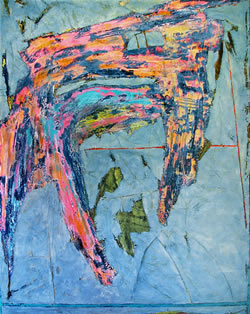Herb Jackson‘s techniques are by now familiar enough – layer on layer of acrylic, sometimes more than 100, cut, slashed, abraded, brushed, palette knifed, textured, and, here and there, providing sudden intervals that seem indefinable. There is, clearly, a surprising continuity in his work, but in 25 canvases and panels large and small, ranging from 1985 to 2011, the Jackson show at the Lee Hansley Gallery revealed what continually surprises me – the enormous variety of his work.
Bright yellows, oranges, greens course through “Hawaii Climb” (1997), but the far more subtle “Parapet” (2000), with areas of greyed golds emerging from thin channels of green and blue, is just as alluring. Anchored by a patch of black glitter, a highly tooled gold form is darkened near the bottom by purples, gets lighter as it moves upward, is topped by another gold band and an orange slab over all.
Glitter flashes from more than one canvas. The large “The End of Tomorrow Begins Tonight” (2008) pulses with bits of mica mixed with blues, oranges, yellows, and light greens. Because of the contrast, patches of flat unglittery light blue force themselves on our attention. Near the center of the canvas, a small area of reticulated blue differs from anything else in the show –- a pattern of thin white lines created by mixing the paint with several layers of watered-down glazes. Other work indicates clearly that Jackson continues to experiment.
The show contains two of Jackson’s extended and extensive Veronica’s Veil series, begun in 1980 and continuing through this year with over 200 five by four canvases. One particularly fine example at Hansley (CXXII, 2004), is largely covered by a flat pale blue, but Jackson has cut into the surface with a large trestle shape pulsating with strokes and slashes of yellows, oranges, pinks. The surface is further cut to reveal a green area, and cut again by sharp lines opening into regions of orange and pink. The enormous variation in the series and in the gallery is indicated by the second Veil (LXVII, 1985). With most of its surface filled by billowing clouds of light greens and blues, it is cut vertically by a spear-shaped red form, horizontally by slabs of reds and oranges at the top, and any number of other cuts and breaks into red layers beneath.
A series of six paintings in the show (dated 2007) reveal Jackson attempting a thoroughly different approach, moving away from his standard acrylics and working with a very different medium –- oil sticks –- that he employs brilliantly; in other hands it can be quite unforgiving. There is some cutting and tooling, a good deal of layering, and textures created by manipulating the sticks, but little of the excavating observed in the acrylics. Because of their nature, oil sticks lend themselves to linear work. In the forceful “Night Visitor,” curving lines of white, blue, gray and red plunge fiercely through the work from a yellowish area at the top to another at the bottom. In “Nervous Suitor,” a gray form suggesting a cow-like head is held in place by a broad inverted triangle outlined by lines and broad streams of pink, red, orange, green and blue. In “White Bone,” thick white lines curve over areas of red, blue, grey in creating surfaces that break into each other.
Since he is not transcribing objects or people or landscapes in front of him, obviously it is the canvas itself that suggests the next stroke for Jackson –- a process of discovery, he says: “Decisions come in response to the emerging painting, and they’re determined non-verbally, so that it’s possible to have a studio session lasting several hours without a verbal thought.” His web page suggests an almost mystic feeling about his approach: “To require that an image, to be a bearer of content, must be recognizable is to suggest that there is no form to the unknowable.” Again: “My inner journey through art confirms, for me, at least, that it is not necessary to rob life of its mystery in order to understand it.”
There may be times when he avoids verbalizing, but the 67 year-old artist-educator is, of course, verbal enough. Having graduated from Davidson College before it had an art department, he began teaching there in 1969, became Art Department chair in 1982, and saw to the creation of Davidson’s large Belk Visual Arts Center in 1993. Now retired, his long list of recent work clearly makes him a workaholic.
Except for a group show, Jackson has not been seen in Raleigh since 2008 when Veronica’s Veils were hung at Artspace. In the 1980’s and ’90’s, his local gallery was Gilliam Peden. Beyond that he is carried nationally and internationally by any number of galleries and museums.
The show continues through October 3. For details, see the sidebar.












